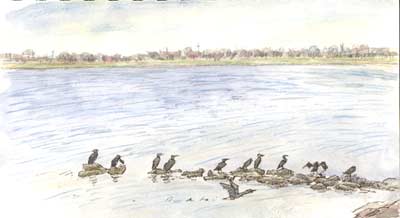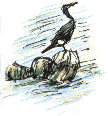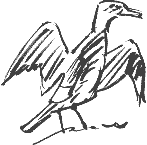
 Cormorants
sitting on rocks: it's a welcome touch of wilderness on a rainy Monday morning,
even if these cormorants are as far from a wild coast as they can be in Yorkshire.
They're sitting on sandstone boulders that have been stacked to make small
islands on the shore of a lake that, at the time of its construction, was
the largest in Britain to be lined with a butyl sheeting: Anglers
Lake, three miles south-east of Wakefield, was constructed on the
site of an opencast coal mine.
Cormorants
sitting on rocks: it's a welcome touch of wilderness on a rainy Monday morning,
even if these cormorants are as far from a wild coast as they can be in Yorkshire.
They're sitting on sandstone boulders that have been stacked to make small
islands on the shore of a lake that, at the time of its construction, was
the largest in Britain to be lined with a butyl sheeting: Anglers
Lake, three miles south-east of Wakefield, was constructed on the
site of an opencast coal mine.
For me cormorants have a rather prehistoric look. They sit on
their rocks like heraldic beasts, spreading their wings to dry, preening or
just staring into space.
 A
passing coot makes a noise like the hooter of a toy car.
When a cormorant flies in there's a grunting and whinnying of welcome (or,
more probably, dispute). I didn't realise that cormorants could be so vocal.
A
passing coot makes a noise like the hooter of a toy car.
When a cormorant flies in there's a grunting and whinnying of welcome (or,
more probably, dispute). I didn't realise that cormorants could be so vocal.
The coot dispute has escalated: one tries to dive out of harm's way as the other pursues it, calling and looking menacing.
 |
 |
 |
|
Cormorant drying its wings. |
Juvenile cormorant. |
Preening. |


 I
find it difficult to draw holding the binoculars in my left hand and the pen
in my right so, instead, as the rain passes and the light gets better, I draw
the cormorants the size that I see them.
I
find it difficult to draw holding the binoculars in my left hand and the pen
in my right so, instead, as the rain passes and the light gets better, I draw
the cormorants the size that I see them.